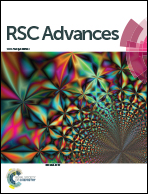A dual-amplification fluorescent sensing platform for ultrasensitive assay of nuclease and ATP based on rolling circle replication and exonuclease III-aided recycling†
Abstract
A robust fluorescent sensing platform for ultrasensitive assay of nuclease has been established based on rolling circle amplification and exonuclease III-aided recycling amplification. Rolling circle amplification (RCA) is an isothermal DNA amplification process that can convert a short DNA primer into a long single-stranded DNA containing a large amount of tandem repeats. In this work, the substrate DNA (sDNA) of S1 nuclease was designed as the primer to generate RCA products that can hybridize with the pre-quenched TaqMan probes and form recessed 3′ terminus double-stranded DNAs. In the presence of exonuclease III (Exo III), the TaqMan probes were digested from the 3′-hydroxyltermini, releasing the fluorophore and generating enhanced fluorescence signals. Meanwhile, the RCA products with 3′ protruding ends were liberated and hybridized with other TaqMan probes, triggering another cycles and obtaining remarkablely increasing fluorescence. However, in the presence of S1 nuclease, sDNA was cleaved into mono- or short-oligonucleotides pieces, which could not cause the RCA reaction and subsequent Exo III-aided recycling amplification reaction, resulting in extremely weak fluorescence. The fluorescence intensity gradually reduced with increasing concentration of S1 nuclease. Due to the double signal amplification, the developed method was demonstrated to exhibit exceedingly excellent sensitivity with a detection limit of 5 × 10−7 U μL−1. The system was also used to establish a turn-on biosensor of ATP since ATP can prevent the S1 nuclease from digesting the sDNA. ATP can be detected in a range of 5 × 10−4 to 0.2 mM with a detection limit of 5 × 10−4 μM and good selectivity. Moreover, the sensing system was used for the real sample analysis with satisfied results.


 Please wait while we load your content...
Please wait while we load your content...